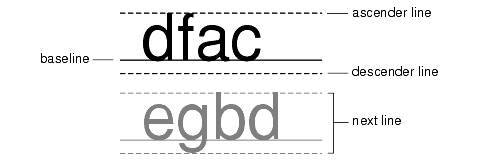Lesson: Working with Text APIs
The Java Tutorials have been written for JDK 8. Examples and practices described in this page don't take advantage of improvements introduced in later releases and might use technology no longer available.
See Java Language Changes for a summary of updated language features in Java SE 9 and subsequent releases.
See JDK Release Notes for information about new features, enhancements, and removed or deprecated options for all JDK releases.
Font Concepts
This section introduces you to the
Font class, which supports the specification of detailed font information and the use of sophisticated typographic features.
A
Font object represents an instance of a font face from the collection of font faces available on the system. Examples of common font faces include Helvetica Bold and Courier Bold Italic. Three names are associated with a
Font object: its logical name, family name, and font face name:
A
Fontobject's logical name is a name mapped onto a physical font, which is one of the specific fonts available on the system. When specifying aFontin Java, use the font face name instead of the logical name. You can get the logical name from theFontby calling thegetNamemethod. To get a list of the logical names that are mapped onto the specific fonts available on a system, call the java.awt.GraphicsEnvironment.getAvailableFontFamilyNames method.See Physical and Logical Fonts for more information.
A
Fontobject's family name is the name of the font family that determines the typographic design across several faces, such as Helvetica. Retrieve the family name through thegetFamilymethod.A
Fontobject's font face name refers to an actual font installed on a system. This is the name you should use when specifying a font. It's often referred to as just the font name. Retrieve the font name by callinggetFontName. To determine which font faces are available on the system, call thejava.awt.GraphicsEnvironment.getAllFontsmethod.
You can access information about a
Font through the
getAttributes method. A
Font object's attributes include its name, size, transform, and font features such as weight and posture.
A
LineMetrics object encapsulates the measurement information associated with a
Font, such as its ascent, descent, and leading:
- Ascent is the distance from the baseline to the ascender line. This distance represents the typical height of capital letters, but some characters might extend above the ascender line.
- Descent is the distance from the baseline to the descender line. The lowest point of most characters will fall within the descent, but some characters might extend below the descender line.
- Leading is the recommended distance from the bottom of the descender line to the top of the next line.
The following figure shows the position of the ascender line, baseline, and descender line:

This information is used to properly position characters along a line, and to position lines relative to one another.
You can access these line metrics through the
getAscent,
getDescent, and
getLeading methods. You can also access information about a
Font object's height, baseline, and underline and strikethrough characteristics through the LineMetrics class.